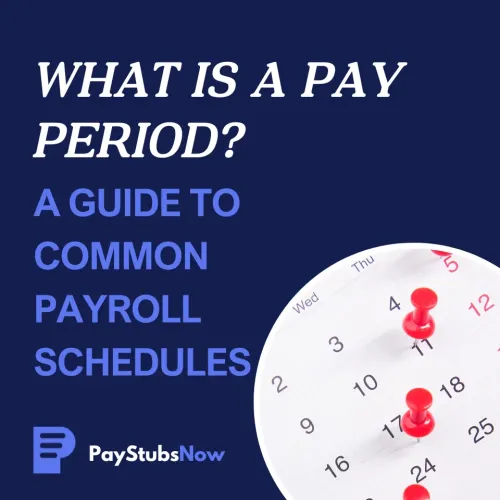


Setting a consistent pay period is one of the most important decisions you’ll make when establishing payroll for your business. It impacts how you manage cash flow, meet compliance requirements, and maintain employee trust.
From options such as weekly, bi-weekly, semi-monthly, and monthly, selecting the right pay schedule for your business can seem confusing. This guide provides clarity on the different types of pay periods, essential factors to consider, and best practices for managing them efficiently.
We will also explore how Paystubsnow can simplify the process of generating accurate paystubs, regardless of the pay period you select.

A pay period is the defined time frame during which employees, whether salaried or hourly, accumulate work hours that then translate into wages . This period determines how often employees receive their paychecks and directly affects payroll processing, cash flow management, and compliance with financial and labor regulations.
According to the U.S. Bureau of Labor , common pay schedules include bi-weekly (43%), weekly (27%), semi-monthly (19.8%), and monthly (10.3%) periods. Choosing the right schedule for your business can simplify administrative tasks and also ensure that your employees' earnings are managed transparently and efficiently.
 It is important to distinguish between a pay period and a pay date. The pay period refers to the span of time during which the work is performed—for example, the week or month during which employees accumulate their hours. In contrast, the pay date is the specific day when the employee actually receives their paycheck and typically falls after the end of the pay period. This distinction is crucial when it comes to:
It is important to distinguish between a pay period and a pay date. The pay period refers to the span of time during which the work is performed—for example, the week or month during which employees accumulate their hours. In contrast, the pay date is the specific day when the employee actually receives their paycheck and typically falls after the end of the pay period. This distinction is crucial when it comes to:
 It can be daunting to figure out the best pay period schedule, from biweekly to monthly, especially when considering administrative costs and payroll schedules. Let’s look at a few different factors that can determine which is best for your business.
It can be daunting to figure out the best pay period schedule, from biweekly to monthly, especially when considering administrative costs and payroll schedules. Let’s look at a few different factors that can determine which is best for your business.
Anyone who has ever had to generate a W-2 knows the IRS requires employers to withhold federal income tax, Social Security, and Medicare contributions based on employee wages. The frequency of paychecks, from overtime to regular pay, is central to calculating these taxes. A well-planned pay period can help streamline these tax obligations and meet the mandated requirements.
Federal law mandates that employers maintain a consistent pay frequency. While the Fair Labor Standards Act (FLSA) does not specify exact pay periods, it requires that employees be paid on a regular, consistent basis. This consistency helps prevent delays in wages and ensures employees are compensated in a timely manner.
However, state laws can vary significantly. Some states require paychecks to be issued within specific timeframes, such as weekly or bi-weekly, while others allow more flexibility. It's important to research and understand the specific pay period regulations in the state where your business operates. Failure to comply can result in fines and penalties.
The time required to process payroll generally increases with the size of your workforce. While small businesses might complete payroll within a day or two, larger organizations may need several days or even weeks, especially when managing bi-weekly cycles and multiple employee classifications.
Each industry tends to have its own norms regarding pay periods. Researching common practices in your sector can help you ensure that your payroll schedule remains competitive and attractive to potential talent.
Frequent pay cycles, such as weekly schedules, can strain your cash flow, whereas longer intervals (monthly or quarterly) may offer more financial stability. Balancing the needs of the business with those of your employees is crucial.
Employees compensated by the hour or on a commission basis often prefer more frequent payouts that align with their earnings schedule. Conversely, salaried employees might be comfortable with bi-weekly or monthly pay structures.
A predictable and consistent pay cycle helps employees plan their finances, whether it’s for day-to-day expenses or long-term budgeting. Many employees prefer bi-weekly pay periods or weekly payroll schedules, rather than monthly pay schedules, as these pay period types allow more frequent access to their earnings.
 So, how many pay periods are in a year? Let's explore the most common options, along with their pros and cons.
So, how many pay periods are in a year? Let's explore the most common options, along with their pros and cons.
As one of the most frequent pay schedules used, especially by businesses with hourly or commission-based employees, weekly pay periods typically result in 52 pay periods in a year, and employees receive their wages at the end of each week.
Pros
Helps employees manage their cash flow as they get paid frequently
Suitable for hourly workers who often prefer smaller, more frequent payments
Facilitates quick adjustments to any payroll errors within a shorter time frame
Cons
Increases payroll costs due to the frequency of processing
Demands greater time and resources from HR and accounting teams
Potential for more frequent payroll errors due to the rapid turnover of payroll deadlines
In a biweekly pay schedule , employees receive their paychecks every other week, which typically equates to 26 paychecks per year.
Pros
Consistent paydays, usually every other Friday
Easier calculation of overtime pay for non-exempt employees
Provides two extra paychecks in months with three pay periods
Cons
May complicate accounting if the number of paychecks differs from month to month
Employees may have to wait slightly longer than a weekly pay schedule to receive their pay
Requires adjustments when aligning pay dates with monthly expenses
With a semi-monthly schedule, employees are paid twice a month on specific dates, such as the 1st and 15th. This schedule is most favored in industries like mining, finance, and information systems.
Pros
Consistency in payroll schedule
Equal paycheck amounts for salaried employees, making financial planning easier
Flexibility in overall budgeting for both employer and employees
Cons
Challenges in Fair Labor Standards Act (FLSA) compliance for non-exempt employees
Restrictions on pay frequency in certain states
This traditional approach is often favored by salaried employees and organizations with a larger workforce. To consistently meet payroll obligations, employees receive their paychecks once a month, typically on the same pay date.
Pros
Simple to administer, reducing administrative burden
Provides a clear financial overview for both employers and employees
Reduces payroll processing costs due to fewer pay runs
Cons
Can complicate personal budgeting due to the longer interval between paychecks
May lead to financial strain if unexpected expenses arise
Potential for higher turnover as some employees may prefer more frequent pay schedules
Quarterly pay periods, where employees are compensated every three months, are less common but can be advantageous as they result in four pay periods per year.
Pros
Reduced administrative burden as payroll is processed only four times a year
Potentially easier to manage cash flow due to fewer payouts
Can simplify financial planning and budgeting for the business
Cons
Infrequent payouts can challenge personal budgeting
Limits opportunities for addressing payroll errors in a timely manner
May not comply with state labor laws requiring more frequent pay intervals
Semi-annual pay periods involve distributing employee wages twice a year. This schedule can be suitable for certain niche businesses or high-level executive compensation.
Pros
Significant reduction in administrative workload and payroll processing costs
Simplified financial planning since payments are only made twice a year
Can be useful for businesses with predictable cash flow patterns
Cons
Extended intervals between paychecks may lead to budgeting issues
Potential for increased employee turnover due to long gaps between paychecks
Not suitable for non-exempt hourly employees due to FLSA compliance issues
An annual pay period consolidates all wages into one paycheck per year—a structure that, while rare, may be used in specialized circumstances.
Pros
Reduces administrative effort, with payroll processed only once a year
Potentially simplifies financial planning for businesses with stable, predictable cash flow
Beneficial for employees in terms of tax management and long-term financial planning
Cons
Increased risk of financial strain on employees, who may struggle with budget management
Challenging to handle any payroll errors, as they have prolonged impacts
Complicates the resolution of payroll errors and may not be appropriate for dynamic work environments
Beyond the traditional schedules, some businesses may explore alternative pay periods to meet unique operational needs:
Understanding the typical number of pay periods in a year can simplify planning for both payroll processing and budgeting. The table below provides a simple overview of common schedules:
Pay Period
Number of Pay Periods
Weekly
52
Bi-Weekly
26
Semi-Monthly
24
Monthly
12
Quarterly
4
Semi-Annual
2
Annual
1
Managing multiple pay periods can become a complex task, especially while ensuring pay stubs are accurate and compliant with regulatory standards. Paystubsnow is a user-friendly platform designed to streamline this process. With the ability to quickly generate professional pay stubs, it offers:
Now that you know about this mighty tool, don't let pay stub generation become a time-consuming headache. Are you ready to manage your company's pay period effectively?